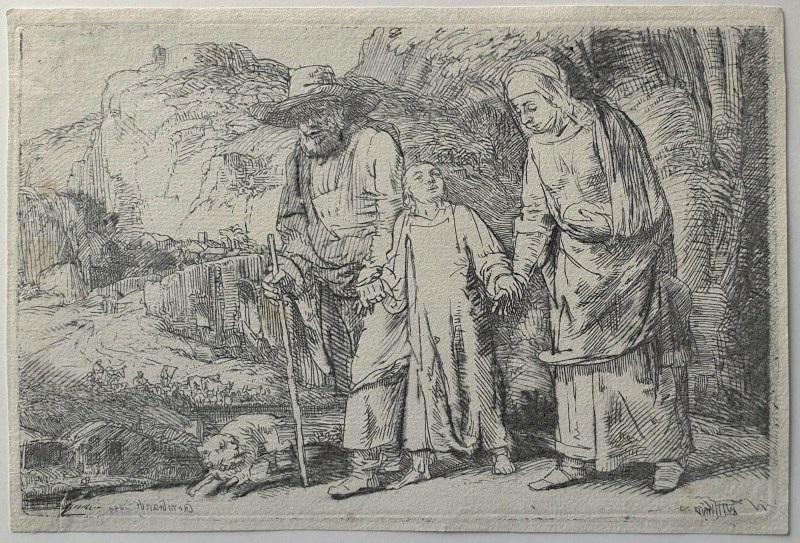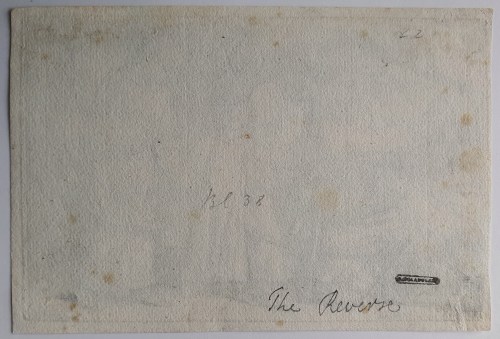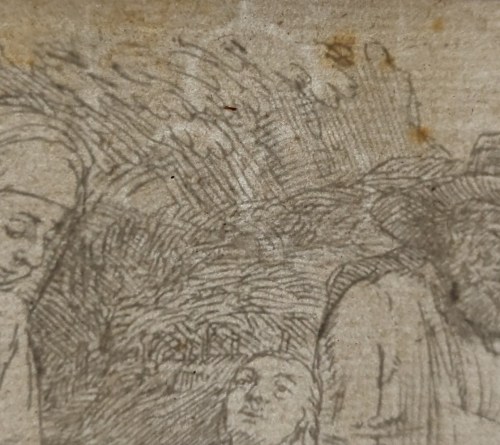REMBRANDT: Christ Returning from the Temple with his Parents - 1654
Price: € 34 000
Bartsch 60; Hind 278; New Hollstein 276, only state.
Counterproof printed on laid paper with part of a Foolscap watermark at the upper edge of the sheet (New Hollstein, text II, p. 227; Hinterding, Foolscap with five-pointed collar, Gb, 1654, vol. II p. 123); small margins with the presence of a platemark offset two millimeters from the subject (sheet 100 x 149 mm).
Annotated in pencil on verso: The Reverse.
Provenance: Charles Delanglade (b. 1870) (Lugt 660) stamped on verso.
Some light foxing; small vertical tear in lower left margin entering 5 mm into the subject; small surface abrasion in upper left corner; otherwise in very good condition.
The New Hollstein catalogue lists three impressions of this etching: British Museum (1843,0607.36), Fitz William Museum (23.K.5-80), Petit Palais, collection Dutuit (GDUT7730)
The counterproofs of Rembrandt's prints that have retained a margin may, like this one, feature a more or less pronounced platemark: for example, Beggars Receiving Alms at the Door of a House; Thatched Cottage and Barn (British Museum); Family of Peasants on a Journey; View of Amsterdam from the Kadijk (Rijksmuseum). Contrary to widespread belief the presence of this platemark testifies to a print made according to the rules of the art by placing the freshly printed impression on the turned-over plate, as Abraham Bosse explains:
"Before I finish, I'll tell you what printers call proof & counterproof: Proof is the first, second or third impression they make from a plate that hasn't yet been printed, or from those that are in the process of being printed again: The counterproof is made with the said proof in this way; namely, having made the proof, it is placed fresh on its reverse side on the plate that made it; then a sheet of soaked paper is placed on the said proof, then the maculature & then the printing blanket; & then the whole is passed between the rollers, & having lifted the said sheet, the proof is found to have made the counterproof on the said sheet of paper: this is usually done to see more easily to correct, especially as the counterproof is according to the drawing, namely turned on the same side. " (Traicté des manieres de graver en taille douce sur l’airin par le moyen des Eaux Fortes, & des Vernix Durs & Mols., 1645, p. 73, translated by us).
We also read in Watelet's Encyclopédie méthodique, in the article Contr’épreuve, that the printing of a counterproof "is useful to printmakers, because it shows them the print they are working on in the same way as the drawing or painting they are copying, & makes them see more easily if they have deviated from it". But the author of the article wisely adds: "However, printmakers quite often neglect to obtain a counterproof of their prints."[1] (translated by us).
Rembrandt may sometimes have printed some counterproofs in order to rework the copperplate, but this does not explain why he often printed several of them, and why they bear no indication, as Christopher White points out[2]. The fact that some counterproofs are printed on Japan paper, such as the one of Jesus returning from the temple with his parents in the Dutuit collection, suggests that he may have been responding to collector demand.
The scene depicted in this print follows Christ Seated Disputing with the Doctors which, as Charles Rosenberg observes, illustrated "an important moment in the Synoptic Gospels, for it marks the first time that the boy, recognizing his destiny, acts independently and challenges the authority of the Old Law"[3]. Charles Rosenberg also points out that Christ Returning from the Temple with his Parents was the first work to deal with the theme of Christ's return to Nazareth with his parents after his dispute with the Temple doctors, and that it has therefore sometimes been misidentified.
Edme-François Gersaint's catalog listed it as a depiction of the Flight into Egypt, and Adam von Bartsch's catalog referred to it as The Return from Egypt. [4] .
Christ Seated Disputing with the Doctors and Christ Returning from the Temple with his Parents illustrate the episode recounted in the Gospel According to Luke: “Every year, Jesus' parents went to Jerusalem for the festival of the Passover. When he was twelve years old, they went up, according to the custom of the festival. Then, when the days were over and they returned, the child Jesus remained in Jerusalem. But his parents did not know it. Believing that he was with their traveling companions, they went a day's journey and looked for him among their relatives and friends. But when they didn't find him, they went back to Jerusalem to look for him. After three days, they found him in the temple, sitting among the teachers, listening to them and asking them questions. All who heard him were struck by his intelligence and his answers. When his parents saw him, they were astonished, and his mother said to him, "Child, why have you done this to us? Behold, your father and I were anxiously looking for you". He said to them, "Why were you looking for me? Didn't you know that I must be in my Father’s house ?" But they did not understand what he was saying. Then he went down with them to Nazareth, and was obedient to them. His mother kept all these things in her heart. And Jesus grew in wisdom, in stature, and in grace, before God and men.” (2, 41-52; our translation)
In Rembrandt's etching illustrating the last verses, the movement of the figures reflects their state of mind: the solidity of Joseph, walking with a firm step, staff in hand, protector of the Child, whose hand he holds tightly in his own; the inspiration of the Christ Child, who holds back his step, eyes raised to heaven, her hand resting on her mother's; the pensive contemplation of Mary, who abandons her hand to that of the Child, whose step she follows.
The composition of the etching is inspired by Rubens' painting The Return of the Holy Family from Egypt (in the Wadsworth Atheneum Museum of Art), whose prints by Schelte Bolswert: Et erat subditus illis (1620) and Lucas Vosterman: Dei et Matris et Filii fvgam in Aegyptam (1620) Rembrandt may have seen. The dramatic tension of the scene in Rembrandt's etching contrasts, however, with the nonchalance and tranquility of the figures in Rubens' painting and the two prints.
References: Abraham Bosse, Traicté des manieres de graver en taille douce sur l'airin par le moyen des Eaux Fortes, & des Vernix Durs & Mols. Ensemble de la façon d'en imprimer les Planches & d'en Construire la Presse, & autres choses concernans les dits Arts, 1645; Claude-Henri Watelet, Encyclopédie méthodique - Beaux-Arts (1788) Panckoucke, 1788, article by M. Levesque, p. 147; Christopher White, Rembrandt as an etcher, Yale University Press, 1999, p. 11; Charles Rosenberg, Rembrandt's Religious Prints: The Feddersen Collection at the Snite Museum of Art, Indiana University Press, 2017.
[1] Claude-Henri Watelet, Encyclopédie méthodique - Beaux-Arts (1788) Panckoucke, 1788, article by M. Levesque, p. 147
[2] Christopher White, Rembrandt as an etcher, Yale University Press, 1999, p. 11
[3] Charles Rosenberg, Rembrandt's Religious Prints: The Feddersen Collection at the Snite Museum of Art. Indiana University Press, 2017, p. 29
[4] Op. cit. p. 239





